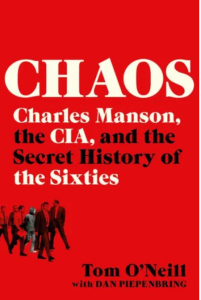The subject matter in Chaos explores many of the general goings on in the 60’s and 70’s, and a few specific ones. Tom O’Neill begins this journey by examining (with a fresh lens independent of Vincent Bugliosi’s Helter Skelter), the Mason murders and leads to the CIA, government cover-ups, frauds, and numerous examples of “this doesn’t look right”. It would be easy to dismiss all of what O’Neill writes about as conspiracy. I’m certain that some will, without even reading his reporting, but doing so would be a closed minded disservice to understanding important facets of what he explores. Speaking of conspiracy, we live in times where discourse, discussion, and debate are largely dead. Instead, we have labels and zero substance – quick one-liners (often labels) that grab attention and fit our societal mentality of the short or non-existent attention span of citizens. This is consistent with the omnipresent cell phone mentality – use of the phone between sets at the gym, use of the phone during in-person meetings whilst someone else is speaking, and even the use of the phone between writing sentences. It should be noted that the book’s title – Chaos, is a reference to the CIA’s domestic espionage program from 1967 to 1974, encompassing numerous government activities.
Chaos starts with this fresh look at the Manson murders, challenging Bugliosi’s Helter Skelter theories. While O’Neill doesn’t purport to have all the answers or a smoking gun, he illustrates, often from public records and interviews, many inconsistencies in the official narratives. Whether related or unrelated, O’Neill uncovers facets of the CIA’s involvement in a number of things that oddly intersect the Manson players, notably its CHAOS and MK-ULTRA programs. Undoubtedly, the CIA was running in the same circles as the Manson family (as was Hollywood), and O’Neill aptly sums up his conclusion that things did not smell right:
“So when I plunged into their stories with Manson and found evidence of serial dishonesty—again, often connected to federal law enforcement and intelligence agencies—I had to ask myself if I was crazy to be doing all of this.”
This book is relatively long, at 528 pages. O’Neill’s contract was cancelled by the original publisher and sustained threats of lawsuits and smears from Bugliosi, but eventually published after O’Neill’s long period of research. An apt summation can be found in O’Neill’s Epilogue:
“My goal isn’t to say what did happen—it’s to prove that the official story didn’t.”
I imagine that since so much time has elapsed between the events described by O’Neill in Chaos and the current day, much of what he writes will be largely ignored. Likely, had this book been written closer to the Manson murders, O’Neill would probably be smeared under the umbrella of something like the Martha Mitchell effect. Doing so would largely be a mistake that seeks to erase important facets of American history, albeit unflattering to law enforcement and the CIA.
O’Neill, Tom and Piepenbring, Dan. CHAOS: Charles Manson, the CIA, and the Secret History of the Sixties. New York, Little, Brown and Company. 2019.


